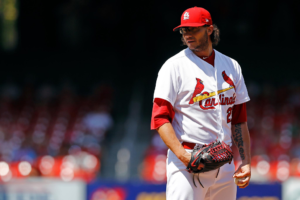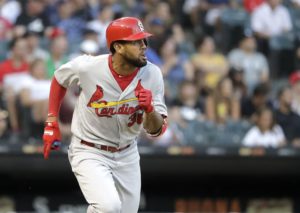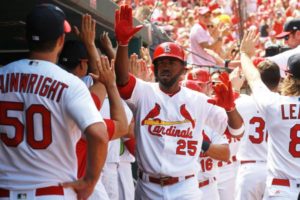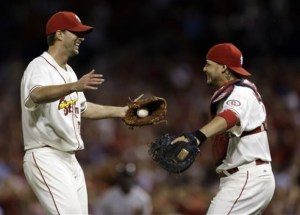The Cardinals ended the season once again sitting just outside of the playoffs. This is the third year in a row that this is the sad result of a season long battle. Although they had a superior second half, Mike Shildt and the Birds will have to find a way to improve moving into the 2019 season. The good news is that the upcoming off-season is looking to have the potential to be one of the biggest and most exciting off-seasons in recent history. Last year’s strange winter break still looming, it should be exciting to see to what level this year’s free agency is effected.
There will be many challenges that Mike Girsch and John Mozeliak are going to face entering this potentially huge off-season. Questions such as what roles need to be filled, who can we trade, and who can we cut/replace. Looking into cutting and replacing there are a few players on the roster that it may be time to cut ties with. While the moves may cost money, when you are only a hand full of games from winning a division and have missed the playoffs narrowly for the third year in a row, it is time to look beyond the monetary cost. What value is being lost with roster holes that are largely effecting season’s outcomes.
- Brett Cecil

Perhaps one of the most disappointing signings in the Mozeliak era is left-handed reliever Brett Cecil. This one arguably trumps the Greg Holland deal simply because of the length and size of the contract. Cecil and Holland were extreme disappointments. Quite possibly the easiest cut that needs to be made is Cecil.
Below is a few stats to illustrate value assessed to the performance of Cecil. While there are many pitchers that could be included in this assessment, the point is pretty clear. The following pitchers are being used for a few reasons. I chose Kershaw because of his monumental contract and effectiveness. Hicks shows an effective young reliever on a rookie contract. Then Mikolas shows an effective starter on a similar price point to Cecil. And Broxton/Siegrist because they were similar in role and usage to what Cecil is.
| Player | Salary | Batters Faced | Cost Per Batter | Earned Runs | Earned Run Average | Strikeouts |
| Brett Cecil | 7,750,000 | 154 | 50,000 | 25 | 6.89 | 19 |
| Johnathan Broxton(2016) | 3,750,000 | 259 | 14,500 | 29 | 4.30 | 57 |
| Kevin Siegrist(2017) | 1,637,000 | 172 | 9,500 | 21 | 4.81 | 43 |
| Miles Mikolas | 7,500,000 | 808 | 9,200 | 63 | 2.83 | 146 |
| Clayton Kershaw | 35,571,429 | 650 | 54,700 | 49 | 2.73 | 155 |
| Jordan Hicks | 545,000 | 339 | 1,600 | 31 | 3.59 | 70 |
When Looking at these numbers, we can draw some interesting conclusions. First, Cecil’s ERA is significantly higher than any other persons in this comparison. There is also the fact that he drew the least number of strikeouts of anybody on this list. What these numbers also show is if we were just showing value in batters faced per year, Cecil draws a cost per batter that is almost as enormous as Clayton Kershaw. There are many other stats/ comparisons that can be made here, but it is profoundly alarming to think that there is any way that Cecil and Kershaw could hold similar value at all
Another comparison I looked at during this assessment was a price per pitch on each of the above players. Additionally, I felt to assess effectiveness, it was also important to look at strike percentage. Cecil shows the lowest strike percentage of the players listed. When coupled with the high ERA from above, and cost per pitch, he seems wildly ineffective. It is troubling that he is showing a cost per pitch value that is nearly as high as Kershaw. And worse still, he is almost 4 times higher that Johnathan Broxton whose cost per pitch is the highest of Cardinals listed below.
| Player | Salary | Number of pitches | Cost Per Pitch | % of pitches for strikes | Average Pitches per Batter |
| Brett Cecil | 7,750,000 | 569 | 13,600 | 60.3 | 3.69 |
| Johnathan Broxton (2016) | 3,750,000 | 1002 | 3,740 | 63.8 | 3.86 |
| Kevin Siegrist (2017) | 1,637,000 | 681 | 2,400 | 61.5 | 3.95 |
| Miles Mikolas | 7,500,000 | 3004 | 2,500 | 69.3 | 3.71 |
| Clayton Kershaw | 35,571,429 | 2364 | 15,000 | 68.1 | 3.63 |
| Jordan Hicks | 545,000 | 1274 | 430 | 60.9 | 3.75 |
Simply put, the value of the contract makes keeping the roster spot filled with Brett Cecil seem even harder to do. He was brought in to be a lefty specialist, and seemingly cannot get outs when it is required of him. Cecil did not have many losses tied to his name this year. However, neither manager trusted Cecil in high leverage situations. Multiple games that were close were put out of reach by the pitcher whose ERA was nearly at 7. When looking at the numbers, it looks as if it is time to part with Cecil. The size of a contract should not dictate how much playing time someone gets, especially when you are trying to get just a couple more wins during a season.
- Luke Weaver

The young rookie of 2017 found his fair share of woe’s in 2018. A young man who looked to have solidified a starting role coming out of 2017, has been met with somewhat of a sophomore struggle. Weaver gave up 75 Earned Runs totaling an ERA of 4.95 to end the 2018 season. He gave up 19 home runs and had a WHIP of nearly 1.50. His effectiveness has fallen into question. Statistics seem to be trending in the wrong direction for the young pitcher. He averaged 3.92 pitches per batter, and faced a total of 609 batters, tossing 2386 pitches. With more of a workload this year, weaver tallied 11 losses, and managed only 7 wins. His struggles seemed to be magnified against the division rival Cubs.
When facing off against the Cubs, Weaver carries a career ERA of 9.00. He has a record of 1-3 and has allowed the Cubs a batting average of .376. When you are trying to win the NL central, you cannot afford losses to the Cubs, and his poor performance against Chicago is troubling. If he remains a Cardinal, he can be assured he will see plenty of that Cubs lineup. As it currently stands, that is not good for Luke Weaver.
As it stands, the Cardinals have some serious depth when it comes to young pitchers. All five of the opening day pitchers from Memphis were making a significant impact on the outcome of the season following the All-Star break. This really shows the significant depth when Memphis could lose that talent and still win a championship. Weaver seems to no longer have a place among this talented starting staff. With so many young arms ready to be in the Big Leagues, it seems it may be time to move Weaver. Maybe not necessarily to another team, but at least moving him to the bullpen permanently. Weaver seems to have the stuff when he is right and could certainly be a good trade piece. His potential as a young competitive pitcher may yield a great return.
- Matt Carpenter

This is a name that is sure to cause a lot of fans reading this to take a double take. Early on in the season, many had called for Carpenter to be released or traded. His unusually slow start was troubling to many. It almost seemed as if the veteran infielder had simply lost his talent, and with that his value plummeted. A few long months later here we are with an MVP candidate sitting near the top of the National League in home runs. Matt really shined during the middle of the season.
So why move on from Carpenter? Well the answer is simple really. We should sell high. Carpenters current value could be seen as potentially very, very large. Carpenter is perhaps worth more as a player now then he has been his entire career. The 32-year-old is in his prime, possibly at the tail end of it. He has been fairly consistent as a high on base percentage guy, and still sees the ball really well. His consistency could be seen as very valuable, and with only one more year guaranteed on his contract, it is possible that this could be the off-season where Carpenter is moved. With a league full of competent first basemen, this may be a hard deal to sell, but potentially a very good one.
- Jose Martinez

Photo Credit: Charles Rex Arbogast/AP
This one seems to be pretty obvious, but Jose doesn’t really belong in the National League. The Cardinals seem to have a log jam currently in right field. Harrison Bader looks to be the go-ahead center fielder, and Ozuna is solidified in left. Right field still hasn’t seen a consistent starter. Tyler O’Neil started to see more playing time as Fowler descended to the disabled list. However, Martinez was to be placed in right to start games because of his bat. This season showed a mix of Bader, Martinez, Fowler, Muñoz, and O’Neil, each seeing their share of right field.
Moving into next season, the question that will be posed once again is where to play Martinez? An easy answer is as a designated hitter. The experiment to play him at first base made many observers nervous. Simply put he didn’t look comfortable there. Placing him in the outfield, he performed better than at first, but still doesn’t seem to be a solid fit. With the potential emergence of O’Neil and the imminent return of Fowler, there just isn’t room for a player who should be playing as a DH. He could bring his offensive power to the DH position in the American League via a trade.

As part of this assessment, I feel it is important to also touch on Fowler. Leaving numbers out of it, something clearly was not right with Fowler this year. If it was bad blood with the old management, nagging injuries, or just poor performance, it is best that he put this season behind him. As a team the best thing for him and the organization is a massive bounce back year in 2019. I think that platooning right is the short answer, I just hope that a healthy and motivated Dexter reemerge next season. As stated with Cecil, contract size should not be the determining factor deciding playing time. Fowler has a record that is solid and packed with consistency. If he cannot show improvement next year, then perhaps he would be the next player on this list.
- Adam Wainwright

Photo: St. Louis Post-Dispatch
This is another difficult assessment to make. Adam has not had a healthy season since 2014. Not unlike the situation with Luke Weaver, there just isn’t room in this starting rotation to sign another questionable starter. Seeing Wainwright emerge back onto the field, pitch somewhat effectively and get outs this year was special. No matter how the situation is looked at, one thing is for sure; Adam Wainwright will cost not only a roster spot, but money and starts that are better placed elsewhere.
This is in no way an assessment on any value of Adam. He is one day going to be a great mentor, coach, or even potentially a manager. He is a great leader, teacher, teammate and friend to this club. Adams value as a starting pitcher, and in the 2006 World Series victory are sure to land him a spot as a Cardinals Hall of Famer. But, simply put, he is a risk and a question mark. Letting him walk has to be a hard decision. The human thing to do is sign the guy because you love having him around. The baseball move is to let Adam walk and enter free agency. As the events about to unfold come to pass, it needs to be clear, the door is always open if he wants to assist in the organization in any other way. If a contract were to be extended, it should be for a position in the bull pen. From the bullpen, he could spot start or use his stuff to get outs where we have struggled to do so this year. If not in the bullpen, then it looks as if we have seen Adams last start as a Cardinal.
Thanks for reading, and I hope that we can all sit back and enjoy what looks to be an incredible off-season.


